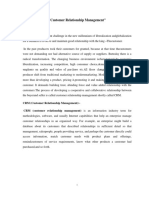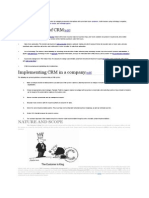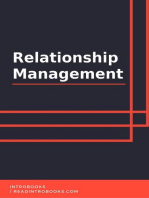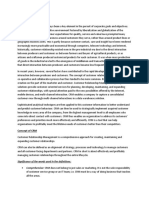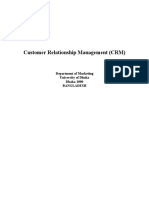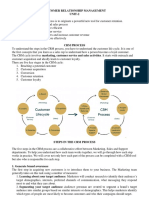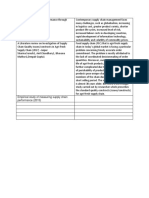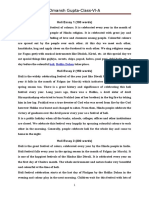Unit I
Unit I
Uploaded by
Vijayendra GuptaCopyright:
Available Formats
Unit I
Unit I
Uploaded by
Vijayendra GuptaOriginal Description:
Original Title
Copyright
Available Formats
Share this document
Did you find this document useful?
Is this content inappropriate?
Copyright:
Available Formats
Unit I
Unit I
Uploaded by
Vijayendra GuptaCopyright:
Available Formats
SANGAM UNIVERSITY-2018-MBA-SEM-IV..
CRM
Introduction:
Today, companies face their toughest competition ever. Moving from a product-and-sales
philosophy to a holistic marketing philosophy, however, gives them a better chance of
outperforming the competition. The cornerstone of a well-conceived holistic marketing
orientation is strong customer relationships. Marketers must connect with customers—informing,
engaging, and maybe even energizing them in the process. Customer centered companies are
adept at building customer relationships, not just products; they are skilled in market
engineering, not just product engineering.
Exchanges And Relationships
Marketing occurs when people decide to satisfy their needs and wants through exchange
relationships.
Exchange is the act of obtaining a desired object from someone by offering something in return.
In the broadest sense, the marketer tries to bring about a response to some market offering.
The response may be more than simply buying or trading products and services. A political
candidate, for instance, wants votes; a church wants membership; an orchestra wants an
audience; and a social action group wants idea acceptance.
The first three steps in the marketing process—understanding the marketplace and customer
needs, designing a customer value-driven marketing strategy, and constructing a marketing
program—all lead up to the fourth and most important step: engaging customers and managing
profitable customer relationships.
Hence, we define marketing as the process by which companies create value for customers and
build strong customer relationships in order to capture value from customers in return.
We first discuss the basics of customer relationship management. Then we will examine how companies go
about engaging customers on a deeper level in this age of digital and social marketing.
Dr Vijayendra S Gupta- 2018 Page 1
SANGAM UNIVERSITY-2018-MBA-SEM-IV..CRM
ORIGIN OF CRM:
CRM originated in early 1970s when the business units had a manifestation that it would be
advisable to become customer emphatic rather that product emphatic. Birth of CRM was because
of this heedful perceptiveness. The famous writer and management consultant Peter F Drucker
wrote; The true business of every company is to make and keep customers. Traditionally every
transaction was on paper and dependent on goodwill which created hindrance in clutching
customers.
Relationship Marketing
Increasingly, a key goal of marketing is to develop deep, enduring relationships with people and
organizations that directly or indirectly affect the success of the firm’s marketing activities.
Relationship marketing aims to build mutually satisfying long-term relationships with key
constituents in order to earn and retain their business.
Four key constituents for relationship marketing are customers, employees, marketing partners
(channels, suppliers, distributors, dealers, agencies), and members of the financial community
(shareholders, investors, analysts).
Marketers must create prosperity among all these constituents and balance the returns to all key
stakeholders.
To develop strong relationships with them requires understanding their capabilities and
resources, needs, goals, and desires.
Dr Vijayendra S Gupta- 2018 Page 2
SANGAM UNIVERSITY-2018-MBA-SEM-IV..CRM
The ultimate outcome of relationship marketing is a unique company asset called a marketing
network, consisting of the company and its supporting stakeholders—customers, employees,
suppliers, distributors, retailers, and others—with whom it has built mutually profitable business
relationships.
The operating principle is simple: build an effective network of relationships with key
stakeholders, and profits will follow.
Thus more companies are choosing to own brands rather than physical assets and are
subcontracting activities to firms that can do them better and more cheaply, while retaining core
activities at home.
Companies are also shaping separate offers, services, and messages to individual customers,
based on information about past transactions, demographics, psychographics, and media and
distribution preferences. By focusing on their most profitable customers, products, and channels,
these firms hope to achieve profitable growth, capturing a larger share of each customer’s
expenditures by building high customer loyalty.
They estimate individual customer lifetime value and design their market offerings and prices to
make a profit over the customer’s lifetime. These activities fall under what Columbia Business
School professor Larry Selden and his wife and business consulting partner, Yoko Sugiura
Selden, call “customer centricity.” The Seldens offer the Royal Bank of Canada as an example.
What is Customer relationship management (CRM):
Customer relationship management (CRM) is the process of carefully managing detailed
information about individual customers and all customer “touch points” to maximize loyalty.
What is called touch points :
A customer touch point is any occasion on which a customer encounters the brand and product—
from actual experience to personal or mass communications to casual observation.
For a hotel, the touch points include reservations, check-in and checkout, frequent-stay
programs, room service, business services, exercise facilities, laundry service, restaurants, and
bars.
The Four Seasons relies on personal touches, such as a staff that always addresses guests by
name, high powered employees who understand the needs of sophisticated business travelers,
and at least one best-in-region facility, such as a premier restaurant or spa.
Dr Vijayendra S Gupta- 2018 Page 3
SANGAM UNIVERSITY-2018-MBA-SEM-IV..CRM
CRM enables companies to provide excellent real-time customer service through the effective
use of individual account information. Based on what they know about each valued customer,
companies can customize market offerings, services, programs, messages, and media. CRM is
important because a major driver of company profitability is the aggregate value of the
company’s customer base.
People used to work hard in entertaining customers by presenting new products with astonishing
services; they were ready to work overtime for grasping more and more customers for increasing
business. This too resulted in customer satisfaction and loyalty up to some extent, but at the end
of the day there was no such bonding or relation between the two to carry on with future business
smoothly.
CONCEPT OF CRM
Customer Relationship Management is a strategic orientation that identifies the most important
long-term customers and develops and understanding of how these customers can be retained.
CRM can be defined as “the strategies, processes, people and technologies used by companies to
successfully attract and retain customers for maximum corporate growth and profit”.
Parvatiyar and Sheth (2000) defined CRM as” a comprehensive strategy and process of
acquiring and partnering with selective customers to create superior value for the company and
the customer”.
Table 1.1 Some Definitions of CRM
• CRM is an information industry term for methodologies, software and usually Internet
capabilities that help an enterprise manage customer relationships in an organized way.
• CRM is the process of managing all aspects of interaction a company has with its customers,
including prospecting, sales and service. CRM applications attempt to provide insight into and
improve the company/customer relationship by combining all these views of customer
interaction into one picture.
• CRM is an integrated approach to identifying, acquiring and retaining customers. By enabling
organizations to manage and coordinate customer interactions across multiple channels,
departments, lines of business and geographies, CRM helps organizations maximize the value of
every customer interaction and drive superior corporate performance.
• CRM is an integrated information system that is used to plan, schedule and control the pre-sales
and post-sales activities in an organization. CRM embraces all aspects of dealing with prospects
and customers, including the call centre, sales force, marketing, technical support and field
service. The primary goal of CRM is to improve long-term growth and profitability through a
Dr Vijayendra S Gupta- 2018 Page 4
SANGAM UNIVERSITY-2018-MBA-SEM-IV..CRM
better understanding of customer behaviour. CRM aims to provide more effective feedback and
improved integration to better gauge the return on investment (ROI) in these areas.
• CRM is a business strategy that maximizes profitability, revenue and customer satisfaction by
organizing around customer segments, fostering behaviour that satisfies customers, and
implementing customer-centric processes.
Importance of Customer Relationship Management (CRM)
Customer Relationship management is the strongest and the most efficient approach in
maintaining and creating relationships with customers. Customer relationship management is not
only pure business but also ideate strong personal bonding within people. Development of this
type of bonding drives the business to new levels of success.
Once this personal and emotional linkage is built, it is very easy for any organization to identify
the actual needs of customer and help them to serve them in a better way. It is a belief that more
the sophisticated strategies involved in implementing the customer relationship management, the
more strong and fruitful is the business.
Most of the organizations have dedicated world class tools for maintaining CRM systems into
their workplace.
1. A CRM system consists of a historical view and analysis of all the acquired or to be acquired
customers. This helps in reduced searching and correlating customers and to foresee customer
needs effectively and increase business.
2. CRM contains each and every bit of details of a customer, hence it is very easy for track a
customer accordingly and can be used to determine which customer can be profitable and which
not.
3. In CRM system, customers are grouped according to different aspects according to the type of
business they do or according to physical location and are allocated to different customer
managers often called as account managers. This helps in focusing and concentrating on each
and every customer separately.
4. A CRM system is not only used to deal with the existing customers but is also useful in
acquiring new customers. The process first starts with identifying a customer and maintaining all
the corresponding details into the CRM system which is also called an "Opportunity of
Business". The Sales and Field representatives then try getting business out of these customers
by sophistically following up with them and converting them into a winning deal. All this is very
easily and efficiently done by an integrated CRM system.
Dr Vijayendra S Gupta- 2018 Page 5
SANGAM UNIVERSITY-2018-MBA-SEM-IV..CRM
5. The strongest aspect of Customer Relationship Management is that it is very cost-effective.
The advantage of decently implemented CRM system is that there is very less need of paper and
manual work which requires lesser staff to manage and lesser resources to deal with.
The technologies used in implementing a CRM system are also very cheap and smooth as
compared to the traditional way of business.
6. All the details in CRM system is kept centralized which is available anytime on fingertips.
This reduces the process time and increases productivity.
7. Efficiently dealing with all the customers and providing them what they actually need
increases the customer satisfaction. This increases the chance of getting more business which
ultimately enhances turnover and profit.
8. If the customer is satisfied they will always be loyal to you and will remain in business forever
resulting in increasing customer base and ultimately enhancing net growth of business. In today‘s
commercial world, practice of dealing with existing customers and thriving business by getting
more customers into loop is predominant and is mere a dilemma.
Installing a CRM system can definitely improve the situation and help in challenging the new
ways of marketing and business in an efficient manner. Hence in the era of business every
organization should be recommended to have a full-fledged CRM system to cope up with all the
business needs.
Types of CRM
Type of CRM Dominant characteristic
Strategic Strategic CRM is a core customer-centric business strategy that aims
at winning and keeping profitable customers
Operational Operational CRM focuses on the automation of customer-facing
processes such as selling, marketing and customer service.
Analytical Analytical CRM is the process through which organizations transform
customer-related data into actionable insight for either strategic or
tactical purposes.
Dr Vijayendra S Gupta- 2018 Page 6
SANGAM UNIVERSITY-2018-MBA-SEM-IV..CRM
Building Customer Value, Satisfaction, and Loyalty
Managers who believe the customer is the company’s only true “profit center” consider the
traditional organization chart in Figure 5.1(a)—a pyramid with the president at the top,
management in the middle, and frontline people and customers at the bottom—obsolete.
Successful marketing companies invert the chart to look like Figure 5.1(b).
At the top are customers; next in importance are frontline people who meet, serve, and satisfy
them; under them are the middle managers, whose job is to support the frontline people so they
can serve customers well; and at the base is top management, whose job is to hire and support
good middle managers.
We have added customers along the sides of Figure 5.1(b) to indicate that managers at every
level must be personally engaged in knowing, meeting, and serving customers.
Figure 5.1(a)—a pyramid with the president at the top, management in the middle, and frontline people and
customers at the bottom - Traditional organisation chart
Figure 5.1(a)— Modern Customer oriented organisation chart
Dr Vijayendra S Gupta- 2018 Page 7
SANGAM UNIVERSITY-2018-MBA-SEM-IV..CRM
Customer Relationship Management (CRM)
Customer relationship management is perhaps the most important concept of modern marketing.
Some marketers define it narrowly as a customer data management activity (a practice called
CRM).
By this definition, it involves managing detailed information about individual customers and
carefully managing customer “touchpoints” to maximize customer loyalty.
Most marketers, however, give the concept of customer relationship management a broader
meaning. In this broader sense, customer relationship management is the overall process of
building and maintaining profitable customer relationships by delivering superior customer value
and satisfaction. It deals with all aspects of acquiring, keeping, and growing customers.
Relationship building blocks: customer Value and satisfaction
The key to building lasting customer relationships is to create superior customer value and
satisfaction. Satisfied customers are more likely to be loyal customers and give the company a
larger share of their business.
Customer Value. Attracting and retaining customers can be a difficult task. Customers often
face a bewildering array of products and services from which to choose. A customer buys from
the firm that offers the highest customer-perceived value—the customer’s evaluation of the
difference between all the benefits and all the costs of a market offering relative to those of
competing offers. Importantly, customers often do not judge values and
costs “accurately” or “objectively.” They act on perceived value.
Customer Satisfaction. Customer satisfaction depends on the product’s perceived performance
relative to a buyer’s expectations. If the product’s performance falls short of expectations, the
customer is dissatisfied. If performance matches expectations, the customer is satisfied. If
performance exceeds expectations, the customer is highly satisfied or delighted.
For customer-centered companies, customer satisfaction is both a goal and a marketing
tool.
Companies need to be especially concerned with their customer satisfaction level today
because the Internet provides a tool for consumers to quickly spread both good and bad
word of mouth to the rest of the world.
Some customers set up their own Web sites to air grievances and galvanize protest,
targeting high-profile brands such as United Airlines, Home Depot, and Mercedes-Benz.
Dr Vijayendra S Gupta- 2018 Page 8
SANGAM UNIVERSITY-2018-MBA-SEM-IV..CRM
How do customers ultimately make choices?
Customer-perceived value (CPV) is the difference between the prospective customer’s
evaluation of all the benefits and all the costs of an offering and the perceived alternatives.
Total customer benefit is the perceived monetary value of the bundle of economic, functional,
and psychological benefits customers expect from a given market offering because of the
product, service, people, and image.
Total customer cost is the perceived bundle of costs customers expect to incur in evaluating,
obtaining, using, and disposing of the given market offering, including monetary, time, energy,
and psychological costs.
(Figure 5.2). Customer-perceived value
Customer-perceived value is a useful framework that applies to many situations and yields rich
insights. It suggests that the seller must assess the total customer benefit and total customer cost
associated with each competitor’s offer in order to know how his or her offer rates in the buyer’s
mind.
Dr Vijayendra S Gupta- 2018 Page 9
SANGAM UNIVERSITY-2018-MBA-SEM-IV..CRM
It also implies that the seller at a disadvantage has two alternatives: increase total customer
benefit or decrease total customer cost.
The former (increase total customer benefit) calls for strengthening or augmenting the
economical, functional, and psychological benefits of the offering’s product, services, personnel,
and image.
The latter (decrease total customer cost) calls for reducing the buyer’s costs by reducing the price
or cost of ownership and maintenance, simplifying the ordering and delivery process, or
absorbing some buyer risk by offering a warranty.
Customers tend to be value maximizers, within the bounds of search costs and limited
knowledge, mobility, and income. Customers choose—for whatever reason—the offer they
believe will deliver the highest value and act on it (Figure 5.2). Whether the offer lives up to
expectation affects customer satisfaction and the probability that the customer will purchase the
product again.
Dr Vijayendra S Gupta- 2018 Page 10
SANGAM UNIVERSITY-2018-MBA-SEM-IV..CRM
Customer Relationship Levels and Tools
Companies can build customer relationships at many levels, depending on the nature of the target
market. At one extreme, a company with many low-margin customers may seek to develop basic
relationships with them.
For example, Procter & Gamble’s Tide detergent does not phone or call on all of its consumers
to get to know them personally. Instead, Tide creates engagement and relationships through
brand-building advertising, Web sites, and social media presence.
At the other extreme, in markets with few customers and high margins, sellers want to create full
partnerships with key customers. For example, P&G sales representatives work closely with
Walmart, Kroger, and other large
retailers that sell Tide. In between these two extremes, other levels of customer relationships are
appropriate.
Beyond offering consistently high value and satisfaction, marketers can use specific marketing
tools to develop stronger bonds with customers.
For example, many companies offer frequency marketing programs that reward customers who
buy frequently or in large amounts.
Airlines offer frequent-flier programs, hotels give room upgrades to frequent guests, and
supermarkets give patronage discounts to “very important customers.” These days almost every
brand has a loyalty rewards program. However, some innovative loyalty programs go a step
beyond the usual.
Creating Customer Loyalty and Retention
Good customer relationship management creates customer satisfaction.
In turn, satisfied customers remain loyal and talk favorably to others about the company and its products.
Studies show big differences in the loyalty of customers who are less satisfied, somewhat satisfied, and
completely satisfied. Even a slight drop from complete satisfaction can create an enormous drop in loyalty.
Thus, the aim of customer relationship management is to create not only customer satisfaction but also
customer delight.
Keeping customers loyal makes good economic sense.
Loyal customers spend more and stay around longer.
Research also shows that it’s five times cheaper to keep an old customer than acquire a new one.
Conversely, customer defections can be costly.
Losing a customer means losing more than a single sale.
It means losing the entire stream of purchases that the customer would make over a lifetime of patronage.
Dr Vijayendra S Gupta- 2018 Page 11
SANGAM UNIVERSITY-2018-MBA-SEM-IV..CRM
Maximizing Customer Lifetime Value
Ultimately, marketing is the art of attracting and keeping profitable customers. Yet every company loses money on
some of its customers. The well-known 80–20 rule states that 80 percent or more of the company’s profits come
from the top 20 percent of its customers. Some cases may be more extreme—the most profitable 20 percent of
customers (on a per capita basis) may contribute as much as 150 percent to 300 percent of profitability. The least
profitable 10 percent to 20 percent, on the other hand, can actually reduce profits between 50 percent to 200 percent
per account, with the middle 60 percent to 70 percent breaking even. The implication is that a company could
improve its profits by “firing” its worst customers.
For example, here is a classic illustration of customer lifetime value:
A company owner, who operates a highly profitable four-store supermarket in Location A and New York, once said
that he sees $50,000 flying out of his store every time he sees a sulking customer. Why?
Because his average customer spends about $100 a week, shops 50 weeks a year, and remains in the area
for about 10 years. If this customer has an unhappy experience and switches to another supermarket, owner
has lost $50,000 in lifetime revenue.
The loss can be much greater if the disappointed customer shares the bad experience with other customers
and causes
them to defect.
To keep customers coming back, owner has created what has been called the “Disneyland of Dairy Stores,”
complete with costumed characters, scheduled entertainment, a petting zoo, and animatronics throughout
the store.
From its humble beginnings as a small dairy store in 1969, owner has grown at an amazing pace. It’s built
30 additions onto the original store, which now serves more than 300,000 customers each week.
Example-II:-
Dr Vijayendra S Gupta- 2018 Page 12
SANGAM UNIVERSITY-2018-MBA-SEM-IV..CRM
Dr Vijayendra S Gupta- 2018 Page 13
SANGAM UNIVERSITY-2018-MBA-SEM-IV..CRM
Customer value analysis :
Very often, managers conduct a customer value analysis to reveal the company’s strengths and
weaknesses relative to those of various competitors. The steps in this analysis are:
1. Identify the major attributes and benefits customers value. Customers are asked what
attributes, benefits, and performance levels they look for in choosing a product and vendors.
Attributes and benefits should be defined broadly to encompass all the inputs to customers’
decisions.
2. Assess the quantitative importance of the different attributes and benefits. Customers are
asked to rate the importance of different attributes and benefits. If their ratings diverge too
much, the marketer should cluster them into different segments.
3. Assess the company’s and competitors’ performances on the different customer values
against their rated importance. Customers describe where they see the company’s and
competitors’ performances on each attribute and benefit.
4. Examine how customers in a specific segment rate the company’s performance against a
specific major competitor on an individual attribute or benefit basis. If the company’s offer
exceeds the competitor’s offer on all important attributes and benefits, the company can charge a
higher price (thereby earning higher profits), or it can charge the same price and gain more
market share.
5. Monitor customer values over time. The company must periodically redo its studies of
customer values and competitors’ standings as the economy, technology, and features change.
Dr Vijayendra S Gupta- 2018 Page 14
SANGAM UNIVERSITY-2018-MBA-SEM-IV..CRM
Definition of Loyalty
# Consumers have varying degrees of loyalty to specific brands, stores, and companies.
# Oliver defines loyalty as “a deeply held commitment to rebuy or repatronize a preferred
product or service in the future despite situational influences and marketing efforts having
the potential to cause switching behavior.”
Definition of Value Proposition:-
*The value proposition consists of the whole cluster of benefits the company promises to
deliver; it is more than the core positioning of the offering.
*For example, Volvo’s core positioning has been “safety,” but the buyer is promised more than
just a safe car; other benefits include good performance, design, and safety for the environment.
*Thus , The value proposition is a promise about the experience customers can expect from the
company’s market offering and their relationship with the supplier
A four-step framework for one-to-one marketing ( IDIC Model )
Don Peppers and Martha Rogers outline a four-step framework for one-to-one
marketing that can be adapted to CRM marketing as follows:
1. Identify your prospects and customers. Don’t go after everyone. Build, maintain,
and mine a rich customer database with information from all the channels and
customer touch points.
2. Differentiate customers in terms of (1) their needs and (2) their value to your
company. Spend proportionately more effort on the most valuable customers
(MVCs). Apply activity-based costing and calculate customer lifetime value.
Estimate net present value of all future profits from purchases, margin levels, and
referrals, less customer-specific servicing costs.
3. Interact with individual customers to improve your knowledge about their
individual needs and to build stronger relationships. Formulate customized
offerings you can communicate in a personalized way.
4. Customize products, services, and messages to each customer. Facilitate
customer interaction through the company contact center and Web site.
Dr Vijayendra S Gupta- 2018 Page 15
You might also like
- Quick Ref Guide - Aqua 2017 - OM17W6QRG - EditedDocument48 pagesQuick Ref Guide - Aqua 2017 - OM17W6QRG - Editedpervaizbutt5774No ratings yet
- Case No. 9 Laying Out Arnold Palmer Hospital's New FacilityDocument2 pagesCase No. 9 Laying Out Arnold Palmer Hospital's New Facilityfer cagsNo ratings yet
- A Study On Customer Relationship Management Towards Reliance Fresh (JNTUH Format)Document80 pagesA Study On Customer Relationship Management Towards Reliance Fresh (JNTUH Format)Satya Kumar100% (1)
- SCDL ProjectDocument37 pagesSCDL ProjectKrisha ChhorwaniNo ratings yet
- Customer Relationship Management in Hotel IndustryDocument66 pagesCustomer Relationship Management in Hotel IndustryFreddie Kpako JahNo ratings yet
- Customer Relationship Management in Hotel IndustryDocument66 pagesCustomer Relationship Management in Hotel IndustryJas77794% (33)
- Dse7410 20mkii Software Manual Enu PDFDocument172 pagesDse7410 20mkii Software Manual Enu PDFParinyaNo ratings yet
- 09 - Chapter 1Document27 pages09 - Chapter 1rukz623No ratings yet
- Customer Relationship Management in Bhel Company HaridwarDocument43 pagesCustomer Relationship Management in Bhel Company HaridwarsudhirNo ratings yet
- "Customer Relationship Management": IntroductionDocument43 pages"Customer Relationship Management": IntroductionsudhirNo ratings yet
- CRM Project Pramila Final 1Document81 pagesCRM Project Pramila Final 1Anonymous r9cNvGymNo ratings yet
- Unit 5.MM - PrinceDocument25 pagesUnit 5.MM - PrinceRahul ShuklaNo ratings yet
- Kipm 071123033733Document22 pagesKipm 071123033733n29604741No ratings yet
- Customer Relationship ManagementDocument11 pagesCustomer Relationship Managementdev_dbcNo ratings yet
- CRMDocument63 pagesCRMSai Kumar PonnaNo ratings yet
- Desing of The StudyDocument9 pagesDesing of The StudyCh TarunNo ratings yet
- (Markenting) CRM SBICAP SECURITIESDocument73 pages(Markenting) CRM SBICAP SECURITIESsantoshnagane72No ratings yet
- Customer Relationship ManagementDocument14 pagesCustomer Relationship ManagementpavasedgeNo ratings yet
- CRM - SPENCER - docx.HYDERDocument79 pagesCRM - SPENCER - docx.HYDERcityNo ratings yet
- Customer Relationship Management: A powerful tool for attracting and retaining customersFrom EverandCustomer Relationship Management: A powerful tool for attracting and retaining customersRating: 3.5 out of 5 stars3.5/5 (3)
- Customer Relationship Management (CRM)Document8 pagesCustomer Relationship Management (CRM)Ayushi SavnerNo ratings yet
- Customer Relationship ManagementDocument4 pagesCustomer Relationship Managementg peddaiahNo ratings yet
- A Study On Customer Relationship Management Towards Reliance Fresh JNTUH FormatDocument79 pagesA Study On Customer Relationship Management Towards Reliance Fresh JNTUH FormatJeetendra DandgeNo ratings yet
- 1 Acknowledgement: Nihar MohapatraDocument4 pages1 Acknowledgement: Nihar MohapatraSekhar singh sekharNo ratings yet
- CRS Text Book Unit 1Document10 pagesCRS Text Book Unit 1Kelly TohNo ratings yet
- CRM PSDA - Reliance Fresh FINALDocument67 pagesCRM PSDA - Reliance Fresh FINALKreepa Chowrasia ABS, NoidaNo ratings yet
- CRM - Customer Relationship Management: Enterprise DatabaseDocument8 pagesCRM - Customer Relationship Management: Enterprise Databaseconfidential86No ratings yet
- Approaches of CRMDocument12 pagesApproaches of CRMKajal Chaudhary0% (1)
- Customer Relationship ManagementDocument5 pagesCustomer Relationship ManagementAbhinandan JenaNo ratings yet
- Customer Relationship Management: Sales Marketing Customer Service Technical SupportDocument26 pagesCustomer Relationship Management: Sales Marketing Customer Service Technical Supportnaseer337No ratings yet
- C C Is A Broadly Recognized, Widely-Implemented StrategyDocument10 pagesC C Is A Broadly Recognized, Widely-Implemented StrategySyed Tauseef RazaNo ratings yet
- Customer Relation Ship Management Jio MMDocument74 pagesCustomer Relation Ship Management Jio MMManav MetelluNo ratings yet
- Electronic Customer Relationship ManagementDocument21 pagesElectronic Customer Relationship ManagementVatsal ShahNo ratings yet
- MMRB SEM 4 - RBM Unit 4 - CRM and Its Types PDFDocument4 pagesMMRB SEM 4 - RBM Unit 4 - CRM and Its Types PDFShem W LyngdohNo ratings yet
- CRM Customer Relationship Management: A.Ayesha SiddiquaDocument13 pagesCRM Customer Relationship Management: A.Ayesha SiddiquaMahesh KumarNo ratings yet
- CRM Chapter-1Document9 pagesCRM Chapter-1imteaz00No ratings yet
- Customer Relationship ManagementDocument5 pagesCustomer Relationship ManagementNeha HittooNo ratings yet
- Customer Relationship ManagementDocument66 pagesCustomer Relationship Managementrocky gamerNo ratings yet
- CRM Unit 1: CRM Basic Notions and Concepts 1.1 What Is CRM?Document23 pagesCRM Unit 1: CRM Basic Notions and Concepts 1.1 What Is CRM?Julia AntolinNo ratings yet
- CRM Unit 1 Notes Introduction To CRMDocument16 pagesCRM Unit 1 Notes Introduction To CRMKeerthi Priya100% (1)
- CRM DrishtyDocument35 pagesCRM DrishtyDrishty SharmaNo ratings yet
- Customer Relationship Management Project ReportDocument19 pagesCustomer Relationship Management Project ReportLokesh Krishnan100% (1)
- INDUSTRY: Banking Project Title: CRM in Axis BankDocument7 pagesINDUSTRY: Banking Project Title: CRM in Axis BankArup BoseNo ratings yet
- Customer Relationship ManagementDocument3 pagesCustomer Relationship ManagementpatrocsNo ratings yet
- Unit 1Document15 pagesUnit 1Bhaskaran BalamuraliNo ratings yet
- CRM Unit 2Document4 pagesCRM Unit 2Raj YadavNo ratings yet
- Executive Summary: The Report Explains The Concept of CRM in Private Bank With The Case Study On ICICI BankDocument56 pagesExecutive Summary: The Report Explains The Concept of CRM in Private Bank With The Case Study On ICICI BankKevin Darryl100% (1)
- HGKKKDocument4 pagesHGKKKAmith RajNo ratings yet
- CRM Chapter 1Document9 pagesCRM Chapter 1ajhorNo ratings yet
- Chapter 3 - Relationship MarketingDocument32 pagesChapter 3 - Relationship MarketingDuy Lê HoàngNo ratings yet
- A Study On Customer Relationship Management in PKR Fashion Clothes at ThirupurDocument41 pagesA Study On Customer Relationship Management in PKR Fashion Clothes at ThirupurMeena SivasubramanianNo ratings yet
- CRM (Customer Relationship Management) : Enterprise DatabaseDocument3 pagesCRM (Customer Relationship Management) : Enterprise DatabaseAngel AneeNo ratings yet
- Unit 1 CRMDocument4 pagesUnit 1 CRMMandeep KaurNo ratings yet
- T.karthick A Study On Customer Relationship Management in PDocument34 pagesT.karthick A Study On Customer Relationship Management in PeswariNo ratings yet
- Customer-First CRM: Develop and Execute Strategies that Elevate Customer Relationships, Enhance Customer Loyalty, and Outperform Your CompetitorsFrom EverandCustomer-First CRM: Develop and Execute Strategies that Elevate Customer Relationships, Enhance Customer Loyalty, and Outperform Your CompetitorsNo ratings yet
- Loyalty.Com (Review and Analysis of Newell's Book)From EverandLoyalty.Com (Review and Analysis of Newell's Book)No ratings yet
- The Entrepreneur's Toolkit: Time Management, Networking, and More for New BuisnessFrom EverandThe Entrepreneur's Toolkit: Time Management, Networking, and More for New BuisnessNo ratings yet
- Customer-Centricity: Putting Clients at the Heart of BusinessFrom EverandCustomer-Centricity: Putting Clients at the Heart of BusinessNo ratings yet
- Choosing A Store LocationDocument18 pagesChoosing A Store LocationVijayendra GuptaNo ratings yet
- Empirical Study of Measuring Supply Chain Performance (2015)Document1 pageEmpirical Study of Measuring Supply Chain Performance (2015)Vijayendra GuptaNo ratings yet
- MBA 203 Project Management Course ManualDocument4 pagesMBA 203 Project Management Course ManualVijayendra GuptaNo ratings yet
- Security Issues in E-Banking An ExplDocument19 pagesSecurity Issues in E-Banking An ExplVijayendra GuptaNo ratings yet
- EssayDocument6 pagesEssayVijayendra GuptaNo ratings yet
- Age How Well You Are Informed About The Project IMS Details CrosstabulationDocument4 pagesAge How Well You Are Informed About The Project IMS Details CrosstabulationVijayendra GuptaNo ratings yet
- Pakistani Print Ad RatesDocument7 pagesPakistani Print Ad RatesMuhammadAbuBaker100% (2)
- Microsoft Excel 2016: Lesson 1Document28 pagesMicrosoft Excel 2016: Lesson 1LESTER CADUYACNo ratings yet
- Cel 2105 THT 10Document9 pagesCel 2105 THT 10212271No ratings yet
- Assignment No. 3 Software EngineeringDocument4 pagesAssignment No. 3 Software EngineeringSoundaryaNo ratings yet
- NSQF - Knitting Machine Operator - Circular KnittingDocument23 pagesNSQF - Knitting Machine Operator - Circular KnittingSakibMDShafiuddinNo ratings yet
- SUNDOO - SH Series Digital Force GaugeDocument2 pagesSUNDOO - SH Series Digital Force GaugeNacho LopezNo ratings yet
- Wa0003.Document5 pagesWa0003.akankshaNo ratings yet
- Scanner Ipcc Paper 4Document34 pagesScanner Ipcc Paper 4Meet GargNo ratings yet
- ServiceOps Asset Manager DatasheetDocument4 pagesServiceOps Asset Manager Datasheetamitdesai92No ratings yet
- 09thick BeamsDocument5 pages09thick BeamsDeepak ChachraNo ratings yet
- Unpaid Sheet 2014Document234 pagesUnpaid Sheet 2014Jagadamba RealtorNo ratings yet
- Installations Us Prog 3 DDocument5 pagesInstallations Us Prog 3 Djlee_296737No ratings yet
- Coffee Project Interview TranscriptDocument5 pagesCoffee Project Interview TranscriptRosie Santos SerranoNo ratings yet
- Lecture 2 - NFTsDocument39 pagesLecture 2 - NFTsleochakravartyNo ratings yet
- Anion Vs Sabitsa ADocument8 pagesAnion Vs Sabitsa AHomer SimpsonNo ratings yet
- SNZ Equiptment Catalogue 24 67.4 MB DigitalDocument92 pagesSNZ Equiptment Catalogue 24 67.4 MB DigitalBogdan CocaNo ratings yet
- UNESCO Poster PresentationDocument3 pagesUNESCO Poster PresentationComfort BulusNo ratings yet
- Sobha AltusDocument34 pagesSobha AltuseGurgaonNo ratings yet
- Energy Efficient Design of Building (A Review)Document15 pagesEnergy Efficient Design of Building (A Review)Saad IlyasNo ratings yet
- Dr. Ram Manohar Lohiya, National Law University, Lucknow: SESSION 2017-2018Document15 pagesDr. Ram Manohar Lohiya, National Law University, Lucknow: SESSION 2017-2018divyavishalNo ratings yet
- 2017 Annual Report PDFDocument52 pages2017 Annual Report PDFWilliam WatterstonNo ratings yet
- 10 Tips Recognize and Prevent Insider Threats PDFDocument1 page10 Tips Recognize and Prevent Insider Threats PDFAlvin BosqueNo ratings yet
- Aerodef IndiaDocument24 pagesAerodef IndiaajayNo ratings yet
- Department of Labor: ET 301 Handbook 5th Ed CHAPTER VI Guide SheetsDocument69 pagesDepartment of Labor: ET 301 Handbook 5th Ed CHAPTER VI Guide SheetsUSA_DepartmentOfLaborNo ratings yet
- Work Immersion TourismDocument3 pagesWork Immersion TourismPom PeiiNo ratings yet
- BeyondDocument13 pagesBeyondsy1990010111No ratings yet
- Navigation in The Enterprise Portal and Business PackagesDocument64 pagesNavigation in The Enterprise Portal and Business PackagesAnonymous 3ZvXNhYNo ratings yet








